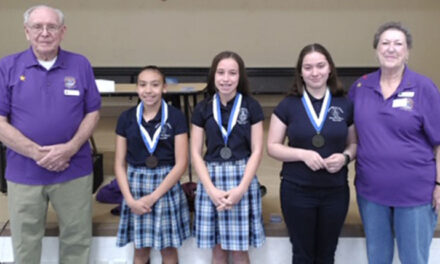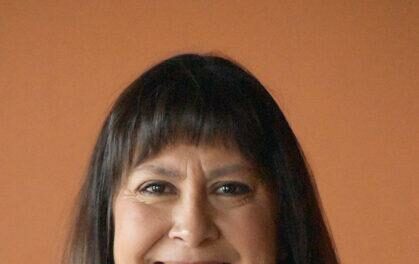Walking onto the Wisconsin Street property last week, the weight of what’s there hits you like a stone foundation. Exposed through careful hand excavation is a stretch of stone foundation very clearly laid out in the shape of half a cross.
It’s been four years of slow, careful work, using trowels and sifters, simple toothbrushes and high-tech mapping equipment. As the final season of the Historic Belen Bioarchaeology Project came to a close last week, investigators are leaving satisfied they did the job they hoped to.
The archaeological dig at Plaza Viejo — the site of the original Our Lady of Belen Catholic Church — started in 2018. That year, a section of foundation was located on the property, immediately to the west of the home now there.

Jesse Jones | News-Bulletin photos
Dr. Claira Ralston, Cristina Freiberger, a graduate student at the University of Nevada Las Vegas, and Camille Morgan, a graduate student at Alabama State University, work to reopen a unit from 2018 where part of the old church foundation was found. With it and the new unit open, investigators will be able to take drone images to show the scope of what was discovered during the dig.
Work continued in 2019 but there was a two year hiatus in 2020 and 2021 due to the COVID-19 pandemic, with the third season picking up in 2022.
This year, with the dig in its final year, Dr. Pamela K. Stone, co-primary investigator for the project, said the team’s main focus was to locate as much of the old church as it could.
As the days counted down, to the west of the unit where the first piece of foundation was found a large section of the footing was located. Working from original documents and descriptions of the church, which wasn’t measured using modern units, Stone started at the first unit and paced off what she believed was the width of the center of the church.
“And there it was,” she said.
While the primary goal of the four-year dig has been to establish that the Wisconsin Street location was indeed where the original Nuestra Señora de Belén was, other minor artifacts and human remains were discovered.

Dr. Pamela K. Stone, co-primary investigator for the Historic Belen Bioarchaeology Project, explains where she and other investigators think the entrance to the church might have been.
In what has now been identified as most likely the center of the church interior, Stone said they found 19 distinct burials, meaning the remains were intact enough to conclude they belonged to one individual. Over years of use, the ground inside the original church was reused for burials, resulting in intermingled bones.
Development and building in the area around the church where the cemetery most likely was also disturbed and intermingled remains.
Stone estimates the cemetery was located to the southwest of the old church, since that is where residents have said they’ve located remains.
“No one to the northeast has told us they found remains,” she said.
With the conclusion of field work, Stone and her co-primary investigator Dr. Debra Martin, a professor of anthropology at the University of Nevada, Las Vegas, will continue to study the ancestral remains found at the site.
“We can learn about the health and wellness of the people who lived here,” Stone said. “Some illnesses can mark the bones.”
They will also be collaborating with Dr. Rick Smith at George Mason University, who is performing DNA analysis of the remains. Smith, a biocultural anthropologist, has taken DNA samples from Belenites, Stone said.
“His process of analyzing the bones is as nondestructive as it can get,” she said. “The analysis is 100 percent voluntary and opt-in.”
Stone said if someone who initially opted in to have their DNA compared to that from remains found at the site, they can change their mind at any time.
“Dr. Smith can pull them out, no problem,” she said, emphasizing that any data gathered by his project would be anonymized and not made public unless the contributor wished to tell others.
All remains found during the project will be re-interred at the current Our Lady of Belen Catholic Church Cemetery, Stone said, most likely sometime in the fall of 2024.
Exploration and analysis of the old church site will enhance the history of the region and the founding families, she said.
The Belen area was originally settled by a group of Genizaro families — formerly enslaved Native Americans — by 1740. Shortly after, Spanish/Mestizo people, some with their Native American servants, migrated from northern New Mexico to Belen, and received the Spanish land grant of Nuestra Señora de Belén, which was initially contested by the established Genizaro community.
“The Genizaro history is one that got missed. It’s a lost history that can be returned to the community,” Stone said. “This is about bringing history back; a way to remember the deep roots to the indigenous community.
“A big part of the project was to make it a community experience, a community conversation. One thing that’s really important to remember is this was community-backed, brought by the community. This is definitely about responsible, community engaged archaeology.”
Julia M. Dendinger began working at the VCNB in 2006. She covers Valencia County government, Belen Consolidated Schools and the village of Bosque Farms. She is a member of the Society of Professional Journalists Rio Grande chapter’s board of directors.

















